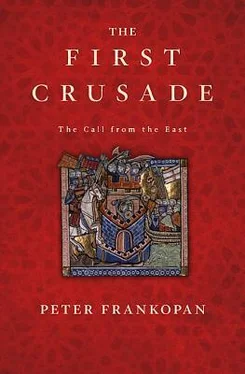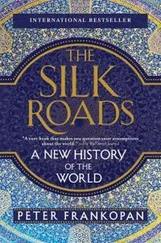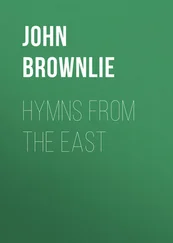4 The Collapse of Asia Minor
1. Miklosich and Müller, 6, pp. 57–8, 40–4. • 2. Anna Komnene, VII.6, p. 199. • 3. Ibid. • 4. Anna Komnene, VII.7, p. 202; VIII.3, p. 220. • 5. Anna Komnene, VI.10, p. 174. • 6. Michael the Syrian, 3, pp. 172ff; Mélikoff, Danismend , 2, p. 88. • 7. Anna Komnene, VII.8, p. 202. • 8. Anna Komnene, VIII.3, p. 220. • 9. R. Macrides, ‘Poetic justice in the Patriarchate: murder and cannibalism in the provinces’, in L. Burgmann, M. Fögen, A. Schmink (eds.), Cupido Legum (Frankfurt, 1985), pp. 144–5. There is no detailed internal evidence to help date the poem more precisely than on stylistic grounds to the eleventh/ twelfth centuries. However, the references to chronic food shortage, severe winter and the desperate measures of the population certainly resonate with the early 1090s. • 10. Anna Komnene, VII.8, pp. 202–3. • 11. Anna Komnene, VIII.3, p. 220. • 12. John the Oxite, p. 35. Also P. Frankopan, ‘Where Advice meets Criticism in 11th Century Byzantium: Theophylact of Ohrid, John the Oxite and their (re)presentations to the Emperor’, Al-Masaq 20 (2008), pp. 71–88. • 13. John the Oxite, p. 35. • 14. Ibid., pp. 29–35. • 15. J. Shepard, ‘How St James the Persian’s head was brought to Cormery: A relic collector around the time of the First Crusade’, in L. Hoffmann (ed.), Zwischen Polis, Provinz und Peripherie. Beiträge zur byzantinsichen Geschichte und Kultur (Wiesbaden, 2005), p. 298. • 16. For example, Robert the Monk, I.1, pp. 79–80. • 17. C. Haskins, ‘A Canterbury monk at Constantinople c .1090’, English Historical Review 25 (1910), pp. 293–5; Ciggaar, ‘Description de Constantinople’, pp. 118–20. • 18. Hagenmeyer, Epistulae , pp. 133–6. • 19. See, most recently, P. Schreiner, ‘Der Brief des Alexios I Komnenos an den Grafen Robert von Flandern und das Problem gefälschter byzantinischer Kaiserschreiben in den westlichen Quellen’, in G. de Gregorio and O. Kresten (eds.), Documenti medievali Greci e Latini. Studi Comparativi (Spoleto, 1998), pp. 111–40; C. Gastgeber, ‘Das Schreiben Alexios’ I. Komnenos an Robert I. von Flandern. Sprachliche Untersuchung’, in ibid., pp. 141–85; C. Sweetenham, ‘Two letters calling Christians on Crusade’, in Robert the Monk’s History of the First Crusade (Aldershot, 2005), pp. 215–18. • 20. See, for example, M. de Waha, ‘La lettre d’Alexis Comnène à Robert Ier le Frison’, Byzantion 47 (1977), pp. 113–25; J. Shepard, ‘Aspects of Byzantine attitudes and policy towards the West in the 10th and 11th centuries’, Byzantinische Forschungen 13 (1988), pp. 106–12. • 21. Hagenmeyer, Epistulae , p. 132. • 22. Ibid. • 23. Hagenmeyer, Epistulae , p. 141; John the Oxite, pp. 37–47. • 24. Anna Komnene, X.5, pp. 273–4. • 25. Shepard, ‘How St James the Persian’s head was brought to Cormery’, p. 299. • 26. Miklosich and Müller, 6, pp. 19–21, 34–8, 42–4, 57–8, 81. • 27. Ibid., pp. 84–90. • 28. Ibid., p. 81. • 29. For the Turk’s footwear, Anna Komnene, IX.1, p. 237. • 30. Miklosich and Müller, 6, pp. 82–3. • 31. Anna Komnene, VIII.3, p. 220. • 32. Matthew of Edessa, II.90, pp. 157–8. • 33. Anna Komnene, VI.12, p. 179. • 34. Jami’al-Tawarikh , p. 62. • 35. Al-Fath ibn ‘Ali al-Bundari, Zubdat al-nusra wa-nukhbat al-‘ursa , ed. M. Houtsma (Leiden, 1889), p. 63. • 36. Ibn al-Atir, AH 485/1092–1093, pp. 258–9. • 37. Gautier, ‘Synode des Blachernes’, pp. 218–19. • 38. Jus Graeco-Romanum, 1, pp. 35–61. • 39. P. Gautier, ‘Jean l’Oxite, patriarche d’Antioche: notice biographique’, Revue des Etudes Byzantines 22 (1964), pp. 136–8. • 40. The towns were taken by the Turks fourteen years after Alexios became emperor. Michael the Syrian, VI.6, vol. 3, pp. 178ff. • 41. Gesta Francorum , IV, p. 25. • 42. Ibid., p. 26. • 43. William of Tyre, III.1, 1, p. 197. • 44. Anna Komnene, XI.2, p. 300. • 45. John the Oxite, p. 35. • 46. Anna Komnene, VIII.7, p. 229. • 47. Anna Komnene, VI.10, pp. 172–3. • 48. Ibid., p. 172; Ibn al-Athir, AH 487/ Dec. 1093–Dec. 1094, p. 271. • 49. Anna Komnene, VI.11, p. 176. • 50. Ibid. • 51. Anna Komnene, VI,11, p. 177. • 52. See, for example, J. Haldon, ‘Theory and practice in tenth-century military administration. Chapters 11, 44 and 45 of the Book of Ceremonies’, Travaux et Mémoires 13 (2000), pp. 201–352. • 53. Anna Komnene, VI.10, p. 175. • 54. Ibid. • 55. Anna Komnene, VI.12. ii–iii, p. 178. • 56. Anna Komnene, VI.12, p. 180. • 57. Ibid. • 58. For the size of Kilidj Arslan’s army in 1097, see, for example, Fulcher of Chartres, I.11. vi, p. 85. • 59. Fulcher of Chartres, I.9.iv–v, p. 80. • 60. Gesta Francorum , II, p. 14. • 61. For example, H. Ahrweiler, ‘L’administration militaire de la Crète byzantine’, Byzantion 31 (1961), pp. 217–28; P. Gautier, ‘Défection et soumission de la Crète sous Alexis Ier Comnène’, Revue des Etudes Byzantines 35 (1977), pp. 215–27; A. Savvides, ‘Can we refer to a concerted action among Rapsomates, Caryces and the emir Tzachas between AD 1091 and 1093?’, Byzantion 70 (2000), pp. 122–34. • 62. Anna Komnene states that her uncle had been governor of Dyrrakhion for eleven years before he was recalled to lead an expedition against western Asia Minor, VII.8, p. 206. Given that Dyrrakhion fell to the Normans in 1082 and was only recovered the following year, the soonest Doukas can have been given command of the efforts against Çaka was 1094. See P. Frankopan, ‘The imperial governors of Dyrrakhion during the reign of the emperor Alexios I Komnenos’, Byzantine and Modern Greek Studies 26 (2002), pp. 89–90. • 63. Miklosich and Müller, 6, pp. 82–3. • 64. Anna Komnene, VII.8, pp. 202–6; IX.1, pp. 238–40; IX.3, pp. 242–4; XI.5, pp. 309–12. • 65. Anna Komnene, XI.5, p. 309. • 66. Richard of Cluny, Chronicon , in L. Muratori (ed.), Antiquitates Italicae , 4, col. 1250.
5 On the Brink of Disaster
1. John the Oxite, pp. 29, 35. • 2. John Zonaras, XVIII.29, 3, pp. 766–7. Zonaras himself fell foul of the Komnenoi, being exiled in the mid-twelfth century after being the highest-ranked judge in the empire. • 3. For the grants to Melissenos, Anna Komnene, III.4, p. 87; John Zonaras, XVIII.21, 3, p. 732; also N. Oikonomides (ed.), Archives de l’Athos: Actes de Docheiariou (Paris, 1984), p. 76. For Adrian, Actes de Lavra , 1, pp. 247–51. • 4. L. Petit, ‘Typikon du monastère de la Kosmosoteira près d’Aenos’, Izvestiya Russkogo Arkheologicheskogo Instituta v Konstantinopole 13 (1908), pp. 19–75. • 5. Frankopan, ‘Imperial governors of Dyrrakhion’, pp. 65–103. • 6. Anna Komnene, VI.9, p. 171. • 7. Michael Taronites and Nikephoros Melissenos, two more of the emperor’s brothers-in-law, were also awarded high titles and honours, as were many members of the Doukas family. Anna Komnene, III.4, p. 87. These awards are well attested in other sources, not least the lead seals issued by these individuals, e.g. Zacos and Veglery, Byzantine Lead Seals , nos. 2698 and 2720 (d). For the Doukas family, see D. Polemis, The Doukai (London, 1968). For the full prosopography of the Komnenoi, see K. Barzos, He Genealogia ton Komnenon , 2 vols. (Thessaloniki, 1984). • 8. See, for example, A. Kazhdan, L’aristocracia bizantina dal principio dell’ XI alla fine del XII secolo (Palermo, 1997), pp. 141–6; J.-C. Cheynet, Pouvoir et contestations à Byzance 963 – 1210 (Paris, 1990), pp. 359ff; P. Magdalino, ‘Innovations in Government’, in M. Mullett and D. Smythe (eds.), Alexios I Komnenos – Papers (Belfast, 1996), pp. 146–66. • 9. P. Frankopan, ‘Kinship and the distribution of power in Komnenian Byzantium’, English Historical Review 495 (2007), pp. 10–13. • 10. Anna Komnene, IV.4, p. 114. For his small stature, II.4, p. 58. • 11. Ibid., p. 115; VI.13, pp. 181–2. • 12. Anna Komnene, V.5, pp. 140–1. • 13. Actes de Lavra , 1, nos. 44–5, 48–9 (1083; 1084; 1086; 1089). • 14. For Aliphas, Anna Komnene IV.6, pp. 122–3. • 15. Theophylact of Ohrid, p. 114; Anna Komnene, VI.13, p. 182. • 16. Manuel Straboromanos, pp. 183–5. • 17. Diegesis merike ton epistolon Alexiou basileios kai Nicholaou Patriarchou genomene kata diaphorous kairous , in P. Meyer (ed.), Die Haupturkunden für die Geschichte der Athos-Klöster (Leipzig, 1894), p. 172. • 18. John Zonaras, XVIII.22, 3, p. 738. • 19. Anna Komnene, III.10, p. 102. • 20. Anna Komnene, V.2, pp. 131–2. J. Stephanou, ‘Le procès de Léon de Chalcédoine’, Orientalia Christiana Periodica 9 (1943), pp. 5–64; V. Grumel, ‘L’affaire de Léon de Chalcédoine, le Chrysobulle d’Alexis Ier sur les objets sacrés’, Revue des Etudes Byzantines 2 (1944), pp. 126–33. • 21. John the Oxite, p. 33. • 22. John Zonaras, VIII.22, 3, p. 732. • 23. John the Oxite, esp. p. 33; also pp. 29, 31, 35. • 24. Actes de Lavra , I, no. 50; Actes de Docheiariou , no. 2; D. Papachryssanthou (ed.), Actes de Xénophon (Paris, 1986), no. 2; J. Lefort, N. Oikonomides and D. Papachryssanthou (eds.), Actes d’Iviron , 2 vols. (Paris, 1985–90), 2, pp. 28–9. • 25. Anna Komnene, IX.2, pp. 240–1. The cause of the revolt can be deduced from the appointment of an official with specific tax responsibilities after authority was eventually restored. Anna Komnene, IX.2, p. 242. See P. Frankopan, ‘Challenges to imperial authority in Byzantium: Revolts on Crete and Cyprus at the end of the 11th Century’, Byzantion 74 (2004), pp. 382–402. • 26. Anna Komnene, VII.8, p. 206; VIII.7, p. 229. • 27. Anna Komnene, IV.2, p. 111. • 28. For example, Dandolo, Chronica brevis , p. 363; L. Lanfranchi (ed.), Famiglia Zusto (Venice, 1955), 6, 9, nos. 1–2. • 29. Although the two oldest copies of the original grant state that concessions were awarded in May 1092, modern scholars have dismissed this on the grounds that a date in the mid-1080s seems to them more appropriate – although the palaeographic, textual and contextual grounds for this are highly questionable. Great store too is set by the positioning of the report of the grant in the Alexiad , even though this is clearly misplaced. For a full discussion here, see T. Madden, ‘The chrysobull of Alexius I Comnenus to the Venetians: The date and the debate’, Journal of Medieval History 28 (2002), pp. 23–41, and P. Frankopan, ‘Byzantine trade privileges to Venice in the eleventh century: The chrysobull of 1092’, Journal of Medieval History 30 (2004), pp. 135–60. • 30. M. Pozza and G. Ravegnani, I Trattati con Bisanzio 992–1198 (Venice, 1993), pp. 38–45. • 31. Ibid., pp. 39–40. • 32. Ibid., p. 43. • 33. Ibid, pp. 40–3. • 34. Dandolo, Chronica per extensum descripta, p. 217. Dandolo does not say why the patriarch was in Constantinople in 1092, only that he died there from fever. • 35. Anna Komnene, VI.7, pp. 166–7; VI.3, p. 156. • 36. Anna Komnene, VII.3, p. 194. • 37. Pozza and Ravegnani, Trattati con Bisanzio , pp. 42–3. • 38. Katakalon Kekaumenos, 81, p. 278. • 39. Anna Komnene, III.10, p. 103. • 40. For the birth of Alexios’ heir, John II, as well as the emperor’s other children, A. Kazhdan, ‘Die Liste der Kinder des Alexios I in einer Moskauer Handschrift (UBV 53/147)’, in R. Stiehl and H. Stier (eds.), Beiträge zur alten Geschichte und deren Nachleben , 2 vols. (Berlin, 1969–70), 2, pp. 233–7. John’s coronation, and its date, can be deduced from A. Spinelli (ed.), Regii neapolitani archivi monumenta edita ac illustrata , 6 vols. (Naples, 1845–61), 5, nos. 457–8, 462, 464–7. • 41. Anna Komnene, VIII.7–8, pp. 229–32. • 42. Anna Komnene, VI.8, p. 168. • 43. Geoffrey Malaterra, III.13, p. 64; Michael the Syrian, 3, p. 176; Bar Hebraeus, 1, p. 227. • 44. Anna Komnene, IX.6, p. 248. • 45. Ibid., p. 250. • 46. Anna Komnene, IX.5, p. 247. • 47. Anna Komnene, IX.7, p. 252. • 48. Anna Komnene, IX.8, pp. 253–4. • 49. Ibid., p. 253, and III.2, p. 81. • 50. Anna Komnene, IX.6, p. 254. • 51. Adrian and Nikephoros reminisced about this when the former was sent to investigate the rumours that Diogenes was plotting against the emperor. Anna Komnene, IX.7, pp. 252–3. • 52. Adrian had become a monk and went by the name of John when he died. B. de Montfaucon, Paleographia Graeca (Paris, 1708), p. 47. For his role in the conspiracy, and the consequences for his family, Frankopan, ‘Kinship and the distribution of power’, pp. 1–34. • 53. For example, Anna Komnene, VIII.3, p. 219; VIII.8, p. 232. For Melissenos, see Frankopan, ‘The Fall of Nicaea’, pp. 153–84. • 54. Melissenos appears only once again before his death, on campaign against the Cumans: Anna Komnene, X.2, p. 264. Alexios often preferred not to leave his rivals in Constantinople but to take them on expedition with him – so he could keep a close eye on them. Almost all the leading figures in Byzantium accompanied the emperor against the Normans in 1081; and of course they were with him during his mission against the Serbs in 1094. • 55. Anna Komnene, III.4, p. 87. • 56. Anna Komnene, XI.10, p. 325; XIII.1, p. 357. • 57. Anna Komnene, IX.8, p. 254. • 58. Ibid. • 59. Anna Komnene, IX.6, p. 250. • 60. Anna Komnene, IX.8, p. 254. • 61. Anna Komnene, IX.9, pp. 255–6. • 62. Ibid., p. 256. • 63. Ibid., pp. 256–7. • 64. Ibid., p. 257. The author is coy about whether her father ordered the blinding of Nikephoros Diogenes. • 65. Anna Komnene, IX.1, p. 237. • 66. Anna Komnene, XV.11, p. 465. • 67. Anna Komnene, IX.2, p. 242; E. Sargologos, La Vie de saint Cyrille le Philéote, moine byzantin (Part 1110) (Brussels, 1964), pp. 35.i–viii, 146–53. • 68. For their careers, see B. Skoulatos, Les personnages byzantins de l’Alexiade: analyse prosopographique et synthèse (Louvain, 1980), pp. 160–1, 85–7. • 69. Anna Komnene, X.9, pp. 286–8; John Zonaras, XVIII.22, 3, p. 739. • 70. Gesta Francorum , IV, pp. 25–6. • 71. Anna Komnene, XI.10, p. 323. • 72. Anna Komnene, XI.3, p. 305. • 73. Anna Komnene, XI.3, pp. 304–5; XI.5, pp. 309–12. • 74. Anna Komnene, VII.8, p. 203; IX.1, p. 238; IX.3, p. 242. • 75. Anna Komnene, X.2, p. 264. For Melissenos’ death, Peter Lambecius, Commentariorum de Augustissima Biblioteca Caesarea Vindobonensi , 8 vols. (Vienna, 1665–79), 5, col. 537. Also see D. Papachryssanthou, ‘La date de la mort du sébastokrator Isaac Comnène’, Revue des Etudes Byzantines 21 (1963), p. 252. • 76. Anna Komnene, X.2–4, pp. 262–73; The Russian Primary Chronicle , tr. S. Cross, and O. Sherbowitz-Wetzor (Cambridge, Mass., 1953), p. 180. • 77. Anna Komnene, XI.2, p. 300.
Читать дальше











